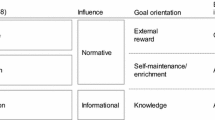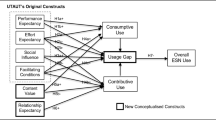Abstract
Literature has paid limited attention to the explanation model of social networking performance. It is argued that a healthy social networking should have a fitting structure among the technology characteristics (e.g., communication and cooperation), social characteristics (e.g., demands of privacy and trust), and individual characteristics (e.g., the tendency of self-realization) to develop its social values in a stable manner. In consequence, this study proposes a conceptual explanation model for social networking performance, which is called Social-Technology Fit Model (STFM). The STFM is based on the theories of technology-performance model and technology-task fit model. The STFM with theoretical arguments and instrument for variables is presented in this paper.
Access this chapter
Tax calculation will be finalised at checkout
Purchases are for personal use only
Similar content being viewed by others
References
Allen B (1990) Information as an economic commodity. Am Econ Rev 80(2):268–273
Bandura A (1986) Social foundations of thought and action: a social cognitive theory. Prentice-Hall, Englewood Cliffs
Bertot JC, Jaeger PT, Hansen D (2012) The impact of polices on government social media usage: issues, challenges, and recommendations. Gov Inf Q 29(1):30–40
Carpenter JM, Green MC, LaFlam J (2011) People or profiles: individual differences in online social networking use. Pers Individ Differ 50(5):538–541
Castelfranchi C (2001) Theory of social functions: challenges for computational social science and multi-agent learning. Cogn Syst Res 2(1):5–38
Chen JV, Ross WH, Huang SF (2008) Privacy, trust, and justice considerations for location-based mobile telecommunication services. Info 10(4):30–45
Csikszentmihalyi M, Csikszentmihalyi IS (1988) Optimal experience: psychological studies of flow in consciousness. Cambridge University Press, Cambridge
Davis FD (1989) Perceived usefulness, perceived ease of use, and user acceptance of information technology. MIS Q 13(3):319–340
Delone WH, McLean ER (1992) Informaiton system success: the quest for the dependent variable. Inf Sys Res 3(1):60–95
Dennis AR, Wixom BH, Vandenberg RJ (2001) Understanding fit and appropriation effects in group support systems via meta-analysis. MIS Q 25(2):167–193
Edwards JR (1991) Person-job fit: a conceptual integration, literature review, and methodological critique. In: Cooper CL, Robertson IT (eds) International review of industrial/organizational psychology. Wiley, New York, pp 283–357
Enders A, Hungenberg H, Denker H-P, Mauch S (2008) The long tail of social networking: revenue models of social networking sites. Eur Manage J 26(3):199–211
Fournier S, Lee L (2009) Getting brand communities right. Harvard Bus Rev 87(4):105–111
Fuller J, Faullant R, Matzler K (2010) Triggers for virtual customer integration in the development of medical equipment—From a manufacturer and a user’s perspective. Ind Mark Manage 39(8):1376–1383
Goodhue DL, Thompson RL (1995) Task-technology fit and individual performance. MIS Q 19(2):213–236
Haefliger S, Monteiro E, Foray D, von Krogh G (2011) Social software and strategy. Long Range Plan 44(5–6):297–316
Hahnel R (2005) Economic justice and democracy: from competition to cooperation. Routledge, New York
Hartmann RW, Manchanda P, Nair H, Bothner M, Dodds P, Godes D, Hosanagar K, Tucker C (2008) Modeling social interactions: identification, empirical methods and policy implications. Mark Lett 19(3–4):287–304
Hoegl M, Schulze A (2005) How to support knowledge creation in new product development: an investigation of knowledge management methods. Eur Manage J 23(13):263–273
Hoffman DL, Novak TP (1996) Marketing in hypermedia computer-mediated environments: conceptual foundations. J Mark 60:50–68
Hogel M, Beisheim O (2005) How to support knowledge creation in new product development: an investigation of knowledge management methods. Eur Manage J 23:263–273
Hsu HY, Tsou HT (2011) Understanding customer experiences in online blog environments. Int J Inf Manage 31:510–523
Jan UA, Contreras V (2011) Technology acceptance model for the use of information technology in universities. Comput Hum Behav 27:845–851
Junglas I, Abraham C, Watson RT (2008) Task-technology fit for mobile locatable information systems. Decis Support Syst 45:1046–1057
Junglas IA, Watson RT (2008) Location-based services. Commun ACM 51(3):65–69
Keng CJ, Ting HY (2009) The acceptance of blogs: using a customer experiential value perspective. Internet Res 19(5):479–495
Kim SK, Trimi S (2007) IT for KM in the management consulting industry. J Knowl Manage 11(3):145–155
Koufaris M (2002) Applying the technology acceptance model and flow theory to online consumer behavior. Inf Syst Res 13(2):205–223
Kristof AL (1996) Person-organization fit: an integrative review of its conceptualizations, measurement, and implications. Pers Psychol 49:1–49
Kwon O, Choi K, Kim M (2007) User acceptance of context-aware services: self-efficacy, user innovativeness and perceived sensitivity on contextual pressure. Behav Inf Technol 26(6):483–498
Mainela T (2007) Types and functions of social relationships in the organizing of an international joint venture. Ind Mark Manage 36(1):87–98
McAfee A (2006) Mastering the three worlds of information technology. Harvard Bus Rev 84:132–144
Paul JA, Baker HM, Cochran JD (2012) Effect of online social networking on student academic performance. Comput Hum Behav 28(6):2117–2127
Shin YY (2004) A Person-environment fit model for virtual organizations. J Manage 30(5):725–743
Smith CD, Mentzer JT (2010) Forecasting task-technology fit: the influence of individuals, systems and procedures on forecast performance. Int J Forecast 26:144–161
Tsoukas, H. (2003), Do we really understand tacit knowledge?. In: Easterby-Smith, Lyles (eds), The blackwell handbook of organizational learning and knowledge management, Blackwell Publishing, Cambridge, pp. 411–427
Vezzetti E, Moos S, Kretli S (2011) A product lifecycle management methodology for supporting knowledge reuse in the consumer packaged goods domain. Comput Aided Des 43:1902–1911
Wasko MM, Faraj S (2005) Why should i share? examining social capital and knowledge contribution in electronic networks of practices. MIS Q 29(1):35–57
Webster J, Ahuja JS (2006) Enhancing the design of web navigation systems: the influence of user disorientation on engagement and performance”. MIS Q 30:661–678
Werbel JD, Gilliland SW (1999) Person-environment fit in the selection process. Res Pers Hum Resour Manag 17:209–243
Wu CH, Kao SC, Shih LH (2010) Assessing the suitability of process and information technology in supporting tacit knowledge transfer. Behav Inf Technol 29(5):513–525
Wu CH, Lee TZ, Kao SC, Lee MM (2010) Examining participation willingness of virtual community using structure equation model. J Stat Manag Syst 13(5):899–920
Author information
Authors and Affiliations
Corresponding author
Editor information
Editors and Affiliations
Rights and permissions
Copyright information
© 2014 Springer Science+Business Media Dordrecht
About this paper
Cite this paper
Liao, HY., Wu, CH., Sundiman, D., Peng, F. (2014). Social-Technology Fit: A Conceptual Model. In: Uden, L., Wang, L., Corchado Rodríguez, J., Yang, HC., Ting, IH. (eds) The 8th International Conference on Knowledge Management in Organizations. Springer Proceedings in Complexity. Springer, Dordrecht. https://doi.org/10.1007/978-94-007-7287-8_30
Download citation
DOI: https://doi.org/10.1007/978-94-007-7287-8_30
Published:
Publisher Name: Springer, Dordrecht
Print ISBN: 978-94-007-7286-1
Online ISBN: 978-94-007-7287-8
eBook Packages: Computer ScienceComputer Science (R0)




